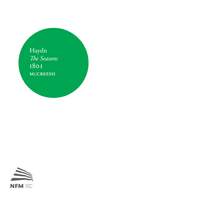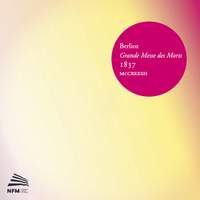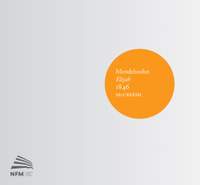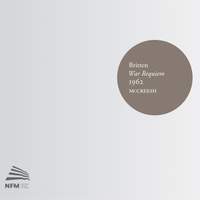Interview,
Paul McCreesh on Haydn's The Seasons
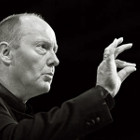 Paul McCreesh and his Gabrieli Consort are well known to many people for their recordings of early music, but lately they have been taking on large-scale historically-informed recordings of Classical and Romantic repertoire as well - Mendelssohn's Elijah and Berlioz's huge Requiem, to name just two. Now they've turned to Haydn's glorious natural tableaux The Seasons, in collaboration with instrumentalists and singers from Wrocław in southwest Poland - a recording that uses a significantly expanded orchestra (with ten horns in some movements!) and also features a new English version of the libretto.
Paul McCreesh and his Gabrieli Consort are well known to many people for their recordings of early music, but lately they have been taking on large-scale historically-informed recordings of Classical and Romantic repertoire as well - Mendelssohn's Elijah and Berlioz's huge Requiem, to name just two. Now they've turned to Haydn's glorious natural tableaux The Seasons, in collaboration with instrumentalists and singers from Wrocław in southwest Poland - a recording that uses a significantly expanded orchestra (with ten horns in some movements!) and also features a new English version of the libretto.
I spoke to Paul about his approach to this latest major project, and about the reception history of The Seasons.
You've opted to perform The Seasons not in the German, nor in the contemporary English translation (which has been much criticised), but in a new English version - what did you hope to achieve with this?
Well, if there is a competition for the world’s most neglected masterpieces, I think The Seasons is definitely in the top ten. Part of the problem is that in the international world where English, for better or worse, is often a primary language for so many people, performing this oratorio in German just doesn’t have that immediacy of communication. And the other thing to remember is that The Creation and The Seasons are the first oratorios to be printed in two languages (English and German) simultaneously, and that sends a very strong message to me that Haydn wanted these pieces to be sung in the vernacular of the audience. Even The Creation was translated into French and Italian within a few years of being written – so I think it’s entirely authentic to perform the piece in English.
There’s no denying that van Swieten (the librettist) simply didn’t speak English well, and the original English version is frankly such a mishmash that it doesn’t serve the music very well – it’s often unintelligible, sometimes to rather comic effect! Clearly it had to go. I haven’t dismissed every single line of the original (though there’s not very much that I’ve actually taken), but what I’ve done is tried to create a text which reads in an eighteenth-century way, and which serves Haydn’s music well. It’s something I’ve been working on for five or six years; and in fact the singers really like it, which is always a good sign. (As with my version of The Creation, which is now being taken off and recorded by other conductors). It was certainly a labour of love and I’m quite pleased with the end result.
Why do you think The Seasons has tended to be overshadowed by The Creation? Do the libretto issues explain it, or is there more to it than that?
I think it’s every bit as great a work as The Creation, and I think a lot of Haydn fans – myself included – would say that possibly it’s the greater work. Musically it’s extraordinary. I think there are a number of reasons for its comparative neglect; obviously the Creation story is one that we all know, and many people have regarded The Seasons as the first secular oratorio, as God gets only the odd reference here and there, But our perceptions of sacred and secular are very different nowadays; in the eighteenth century, the daily work and enjoyment of one’s life were all part of one’s praise to the maker. Its almost the sequel to the Creation.
So on one level people might think this work slightly heavy going, but actually the music (and now, I hope, the text too) is full of the most amazing joy and a tremendous sense of fun. Of course it’s an idealised world, (as is the Garden of Eden in The Creation). The reality was that seventeenth- and eighteenth-century Germany peasants often suffered great poverty. But there is also this wonderful sense of nostalgia which has slight overtones of Hardy – this celebration of the old world, which I find really very attractive. In that sense The Creation and The Seasons are really the opposite sides of the same coin – Haydn the old man looking back on the world, which he knew was changing with the Industrial Revolution in England and the incredible political upheavals in Europe at the end of the eighteenth century. And here I think Haydn is to some degree saying farewell to this old world which he knew and loved so well, and there’s a tremendously touching valedictory quality in this piece. This is summed up especially well in that last bass aria, where the idea of the seasons becomes a metaphor for life, and when you hear that aria it sums up the whole of what’s gone before. Of course it’s the most thrillingly visceral music that Haydn ever wrote and the orchestration is full of the most amazing effects, but I think it does work on a much deeper plane. Yet at the same time there’s a light-heartedness of approach; the duet in Autumn is a wonderful piece with a real sense of 'Papageno, Papagena'. This work had got everything the eighteenth century and early nineteenth century can offer, but there is also an overriding arc which I think is very impressive.
It’s known that Haydn had some objections to the level of pictorialism that ended up in this most vivid of works: The ‘Frogs’ section, in particular, seems to have caused a minor furore between him and his employer! Do you think he manages to stay on the right side of good taste in portraying frogs, bees, huntsmen, drunken revellers and so on?
It is what it is. It’s a beautiful depiction of our world, and that includes birds and bees and so on. Of course Haydn himself was slightly pejorative in a tongue-in-cheek way about the imagery that he was obliged to paint, because of course he knew perfectly well that he could do it better than anybody else! I think there’s a temptation for all of us: we disparage what we do best. But these effects pass so quickly that there’s a huge variety of textures – the gloriously light and beautifully-written songs, the massive, thrilling orchestral storms and drinking-songs, and this amazing hunting scene. It’s painted with such a sense of detail – the score repays hours of looking because you constantly notice new things. It really is a work of genius, not just a catalogue of effects. To me, it grows into something far greater than that.
The Seasons contains a fascinating fusion of the highbrow and the lowbrow – the uplifting hymn-like praises of God juxtaposed with rustic wit. Do you think there’s a contradiction here?
This highbrow-lowbrow thing, and the sacred-secular divide, is something that leads us to judge the oratorio by the wrong criteria because we put a very twentieth-century analysis on it. For your eighteenth-century believer, the joy of earthly love is part of nature and the divinely ordained plan; so there is no great discrepancy in a love song, even with a degree of humour, being followed by a chorus in praise of God. Take Spring, for example – there’s no mention of God at all until the last chorus, and then in just one very small line, after a charming duet between the chorus’s men and women, we’re very delicately reminded by Simon the father-figure that all these feelings that we naturally sense are all part of God’s plan; that then leads into a vast, thrilling paean.
It’s a very natural connection, and refreshingly free of Catholic guilt - something I find very charming. Exactly as in The Creation, in that there’s just that one little line at the end (“O happy pair…”), where you find a very oblique reference to the concept of Original Sin, and that’s all. Haydn was never interested in that: there’s that quotation that whenever he had trouble composing, a walk through the country and a few Ave Marias would always create something new in his mind, and my own favourite quotation is that when he was writing a Credo, he didn’t want to spend too much time dwelling on the Crucifixion because ultimately it was the joy of belief that thrilled him. I think you get that wonderful sense of joie de vivre in Haydn.
The orchestra on this recording is a colossal one – triple woodwind and at times up to ten horns! We know that this has some authentic basis in performances from Haydn’s time – what led you to reconstruct those large-scale events on this recording (and why do you think nobody’s ever tried it before with The Seasons)?
Simply because it’s so expensive! But reality is that the Classical world is not a world of small orchestras. We only believe it is because of the limited amount of money we’ve got to play with, so we go around with four or five first violins. But Handel himself did Solomon with 24 first violins, and Haydn was frequently used to large orchestras. When he did the London Symphonies in London, the woodwind were always doubled. When Mendelssohn did Elijah, again, the woodwind and brass were doubled. So the whole period of the eighteenth and early nineteenth century is a period when large orchestras were often used. It wasn’t something invented by Berlioz.
It’s simply a bigger toy with which to play. You have all the possibilities of a small orchestra but then, as you can hear in this recording, when you get to those big tuttis and you hear that colossal sound, particularly if the wind are relatively loud compared to the strings with these increased forces, it just enables you to use those forces in a very dramatic way. The hunting chorus sounds absolutely thrilling with the horns. It really makes Mahler 1 look like an understated piece of salon music. There is again a sort of visceral imagery in the music, this bringing-in of the outdoors in this great hunt scene, and I feel that with large forces you just have so much more potential. It’s a wonderful sound when you have these big string orchestras with proper gut strings. There is a tremendous richness in the sound, which is a very different sound to a big modern orchestra with metal strings.
For me it gives you so many more possibilities. I’ve made the assumption that the arias must have been played by a smaller orchestra, otherwise they would sound ridiculous; I do use the ripieno forces quite sparingly – they’re only playing for 20 or 25 percent of the piece, and even in the choruses there are clear places to reduce to give more of a sense of colour...but when they play you gettiing a thrilling sense of the enormity of the conception.
The Seasons is set for release on 24th March on Signum Classics.
Available Formats: 2 CDs, MP3, FLAC, Hi-Res FLAC
Related recordings from Paul McCreesh and the Gabrieli Consort
Available Formats: 2 CDs, MP3, FLAC
Available Formats: 2 CDs, MP3, FLAC, Hi-Res FLAC
Available Formats: 2 CDs, MP3, FLAC


